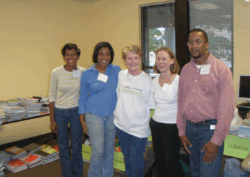What does it mean to invest in the future of your community? For many Alexandrians, the answer goes beyond annual donations or volunteer hours—it’s about creating a lasting impact that will benefit the causes they care about for generations to come. Think Ahead Alexandria is a legacy initiative benefiting Alexandria nonprofits. ACT amplifies the work of our community by bringing people and resources together—we believe that planned giving represents one of the most powerful ways to extend that impact far into the future.
We’re sharing the personal stories of community members from all walks of life who have chosen to “think ahead” by designating nonprofits in their wills and estate plans. These aren’t simply case studies on financial planning—they’re stories about values, vision, and the deep connection our neighbors feel to the causes that matter most to them. Whether you’re already considering planned giving or this is an entirely new concept for you, we hope these stories will illuminate both the personal fulfillment and community impact that comes from thinking ahead. After all, legacy giving isn’t just about the size of the gift—it’s about the intention behind it and the lasting change it can create.
At Carpenter’s Shelter, the mission to support individuals and families experiencing homelessness is fueled by more than just generous donations. It’s powered by enduring relationships and deeply personal commitments. One of the most transformative of those commitments came from longtime volunteers Mike and Ginny, whose legacy gift has ensured the shelter’s future for years to come.

Ginny Royal (third from left) with fellow Carpenter’s Shelter volunteers
Mike and Ginny weren’t strangers to Carpenter’s Shelter. Every Thanksgiving, they stepped into the shelter’s kitchen, not just to serve food but to serve community. “Their main way in which they wanted to engage with Carpenter’s, they would be in our kitchen on Thanksgiving at lunchtime in order to make and serve Thanksgiving lunch to the residents of the shelter,” said Executive Director Shannon Steene. They believed in the mission and wanted to be a part of it, year after year.
When Ginny passed in 2013, Mike kept that tradition alive. But his involvement was more than symbolic. He had promised Ginny that their support for the shelter would continue long after both of them were gone. In 2016, after Mike’s passing, Carpenter’s Shelter was notified by a financial institution that they had been named as a beneficiary. The total: a $1.4 million legacy gift, carefully planned, intentionally designated, and profoundly impactful.
Mike and Ginny made a strategic decision. They wanted to make sure Carpenter’s Shelter would be here for future generations. “That gift moved us past a critical financial threshold and allowed us to begin putting 5% of our investments each year directly into programs that support our mission,” remarked Shannon.
The ripple effects of their generosity have been heartfelt, practical, and powerful. “It’s helped take the financial edge off some tough years,” Shannon said. “To be able to have that cushion and that buffer to not have to live hand-to-mouth is remarkable in that sense. And so I think that’s the main way in which I think of Ginny and Mike’s legacy, to just provide assurance to the shelter over time that people that need this service will have it here for them.”
Legacy giving is now an essential part of the Carpenter’s Shelter financial model, primarily through bequests. But Shannon is clear: the conversations around planned giving aren’t about technical jargon, but about connection. “Not everyone wants to talk about legacy giving,” he says, but “what people do want to talk about is the importance they feel our Carpenter’s mission has.” He says they want to know how to continue to power the work and mission of the shelter, “and I think, that’s the beauty of legacy giving, is that it gives people that opportunity.”
For organizations looking to start or grow their legacy giving efforts, Shannon’s advice is practical: be conversant and not intimidating. “Make it easy. Include information on your website. Encourage people to speak with their advisors. You don’t have to make it the centerpiece of your pitch. Just make sure it’s on the menu.”
Mike and Ginny’s story reminds us that legacy gifts aren’t just financial transactions. They’re purposeful acts of trust and vision. Their gift to Carpenter’s Shelter wasn’t just about honoring a promise between two people. It was a declaration of confidence in the shelter’s role in the community, and an investment in its ability to serve future generations. Shannon gets choked up when he says, “This work of legacy giving is heart work – and it’s powerful to be able to help donors achieve what they want well beyond their time here on this earth.”
Thanks to their foresight and generosity, that investment is already hard at work, powering the mission they believed in and supporting Alexandrians in their greatest times of need.
